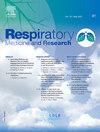支气管内瓣膜(EBV)插入治疗严重肺气肿不能改善骨骼肌质量或功能:一项19例患者的初步研究
IF 1.8
4区 医学
Q3 RESPIRATORY SYSTEM
引用次数: 0
摘要
支气管内瓣膜(EBV)插入治疗严重肺气肿可以减少慢性阻塞性肺疾病(COPD)患者的恶性膨胀并缓解呼吸道症状。然而,很少有研究探讨其对肺外表现的影响。我们试图评估EBV插入对骨骼肌质量和功能的影响,并确定骨骼肌参数是否可以代表EBV插入反应的预后因素。我们进行了一项包括19名患者的单中心前瞻性先导研究。肺的详尽评估;骨骼肌参数在基线和EBV植入后3个月和6个月进行。我们的主要目的是评估6个月骨骼肌参数的变化,即通过生物阻抗分析评估身体成分(阑尾骨骼肌质量指数、脂肪质量、相位角),通过ct扫描评估胸肌(胸肌、竖脊肌、第五肋间肌、腰肌)的表面和密度,以及通过握力测试评估上肢力量。EBV植入3个月后肺功能显著改善,并持续到6个月。相比之下,骨骼肌参数没有明显改善。此外,没有发现肌肉参数或肌肉减少状态可以预测EBV插入的反应。这些结果表明,在我们的研究中,EBV插入与强烈的全身效应无关,并强调需要寻找自下而上的药物策略来治疗copd相关的肌肉减少症。本文章由计算机程序翻译,如有差异,请以英文原文为准。
Endobronchial valve (EBV) insertion for severe emphysema does not improve skeletal muscle mass or function: A pilot study on 19 patients
Endobronchial valve (EBV) insertion for severe emphysema allows to reduce hyperinflation and alleviates respiratory symptoms in patients with chronic obstructive pulmonary disease (COPD). However, few studies investigate its effect on extra-pulmonary manifestations. We sought to assess the effect of EBV insertion on skeletal muscle mass and function, as well as determine if skeletal muscle parameters could represent a prognostic factor for response to EBV insertion.
We conducted a monocentric prospective pilot study including 19 patients. Exhaustive evaluation of lung & skeletal muscle parameters was performed at baseline and 3 and 6 months after EBV insertion. Our primary aim was to assess the 6-month change in skeletal muscle parameters i.e. assessment of body composition with bioimpedance analysis (appendicular skeletal muscle mass index, fat mass, phase angle), evaluation of thoracic muscles (pectoralis, erector spinal, 5th intercostalis, psoas) surfaces and densities on CT-scans, and of upper limb force with handgrip test.
EBV insertion led to a significant improvement of lung function after 3 months and persisting at 6 months. In contrast, no significant improvement was observed in skeletal muscle parameters. In addition, no muscle parameter nor sarcopenic status was found to predict response to EBV insertion.
These results suggest that EBV insertion is not associated with strong systemic effects in our study, as well as emphasize the need to find bottom-up drug strategies for COPD-associated sarcopenia.
求助全文
通过发布文献求助,成功后即可免费获取论文全文。
去求助
来源期刊

Respiratory Medicine and Research
RESPIRATORY SYSTEM-
CiteScore
2.70
自引率
0.00%
发文量
82
审稿时长
50 days
 求助内容:
求助内容: 应助结果提醒方式:
应助结果提醒方式:


